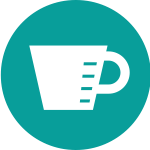
Potassium and Kidney Disease
Potassium is an important mineral, it helps regulate your heart rhythm. It’s found in lots of foods and doesn’t cause a problem for people with healthy hearts and kidneys. But when you have chronic kidney disease (CKD), your kidneys have trouble keeping your potassium levels balanced. When your level is too high or too low, it can cause:
- An irregular heartbeat
- A heart attack
My foods to choose
Shopping gets easier with a pocket list of foods to choose for CKD.
Foods to choose for CKDKnow Your Potassium Numbers
For a person with CKD, a good daily amount of potassium is typically about 2,000 mg. However, check with your doctor or dietitian to find out how much potassium is right for you.
Here are some basic guidelines when thinking about your kidney-friendly diet and potassium. Let’s start by looking at what foods are high or low in potassium.
High-potassium foods



Potassium portion control means you’re in control
Portion control helps you control your potassium levels. A portion is generally one half cup. Remember, eating more than one portion can turn a lower-potassium food into a high one—simply because of the amount you’re eating.
